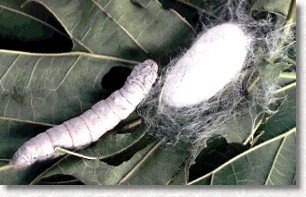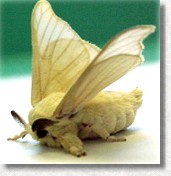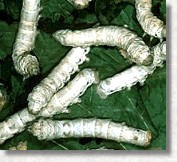 Lepidoptera Bombycidae Bombyx mori
Lepidoptera Bombycidae Bombyx mori
 The silkworm isnít really a worm, it's a caterpillar. The silkworm has been used by people for over 4,000 years to make silk. The practice first began in China in about 2600 BC. The Chinese kept the secret of producing silk for thousands of years, trading silk to Europe and the Middle East. But eventually the secret of how to get silk from the silkworm was learned by other countries. More recently we have learned how to make silk-like material from synthetic materials, but the demand for real silk is still high, and silkworms are still raised for the silk threads they produce. The silkworm isnít really a worm, it's a caterpillar. The silkworm has been used by people for over 4,000 years to make silk. The practice first began in China in about 2600 BC. The Chinese kept the secret of producing silk for thousands of years, trading silk to Europe and the Middle East. But eventually the secret of how to get silk from the silkworm was learned by other countries. More recently we have learned how to make silk-like material from synthetic materials, but the demand for real silk is still high, and silkworms are still raised for the silk threads they produce.
 The practice of raising silkworms is called sericulture.
The silkworm, when fully grown, reaches a length of about 5 to 7 centimetres, and it's an amazing worker. In only a few days, a single silkworm spins a cocoon from which can be removed a silk thread up to 600 metres in length. But it still takes about
25,000 cocoons to make half a kilogram of raw silk. Most of the silk today is produced by China and India, and a few other countries. 60,000 tonnes of raw silk are made each year, and are turned into dresses, shirts, bed sheets, curtains, and other products. It's a big industry, especially in China, where ten million Chinese farmers grow silkworms, and another half million make silk fabrics. There are 600 silk weaving mills in China. The practice of raising silkworms is called sericulture.
The silkworm, when fully grown, reaches a length of about 5 to 7 centimetres, and it's an amazing worker. In only a few days, a single silkworm spins a cocoon from which can be removed a silk thread up to 600 metres in length. But it still takes about
25,000 cocoons to make half a kilogram of raw silk. Most of the silk today is produced by China and India, and a few other countries. 60,000 tonnes of raw silk are made each year, and are turned into dresses, shirts, bed sheets, curtains, and other products. It's a big industry, especially in China, where ten million Chinese farmers grow silkworms, and another half million make silk fabrics. There are 600 silk weaving mills in China.
Around the world there are different varieties of silkworm used to make different types of silk; there is even one type of silkworm that makes a coccoon together with another silkworm, producing a double-thread! Although synthetic fibers such as nylon and polyester, which are stronger than silk and lower in price, have turned silk into a luxury product, silk is still in demand because of its superior look and feel.
  A silkworm moth is yellowish-white, with a thick, hairy body, and a wingspread of about 4 cm. The adults live only a short time ... long enough for the female to lay her eggs. The larvae, which hatch in about ten days, are about half a centimetre long. Larvae in captivity are fed their favourite food, the leaves of the white mulberry plant, so they will produce the finest quality silk. Full-grown larvae are up to 7 cm long, and yellowish-gray in color. A silkworm moth is yellowish-white, with a thick, hairy body, and a wingspread of about 4 cm. The adults live only a short time ... long enough for the female to lay her eggs. The larvae, which hatch in about ten days, are about half a centimetre long. Larvae in captivity are fed their favourite food, the leaves of the white mulberry plant, so they will produce the finest quality silk. Full-grown larvae are up to 7 cm long, and yellowish-gray in color.
After about six weeks of continuous eating, the larvae climb to the top of a branch and spin their coccoon. It takes about six days, and to do it they produce one continuous long silk thread. They will emerge from their coccoon after several weeks of pupating, as adult moths. But on silkworm farms, only enough adult moths are allowed to emerge to ensure continuation of the species, since they destroy the coccoon when emerging. The remaining silkworms are killed by heat while they are inside their coccoons, so that the silk can be drawn off and spun into threads, and woven into fabric.
Resources
HTML, graphics & design by Bill Willis 2023
|